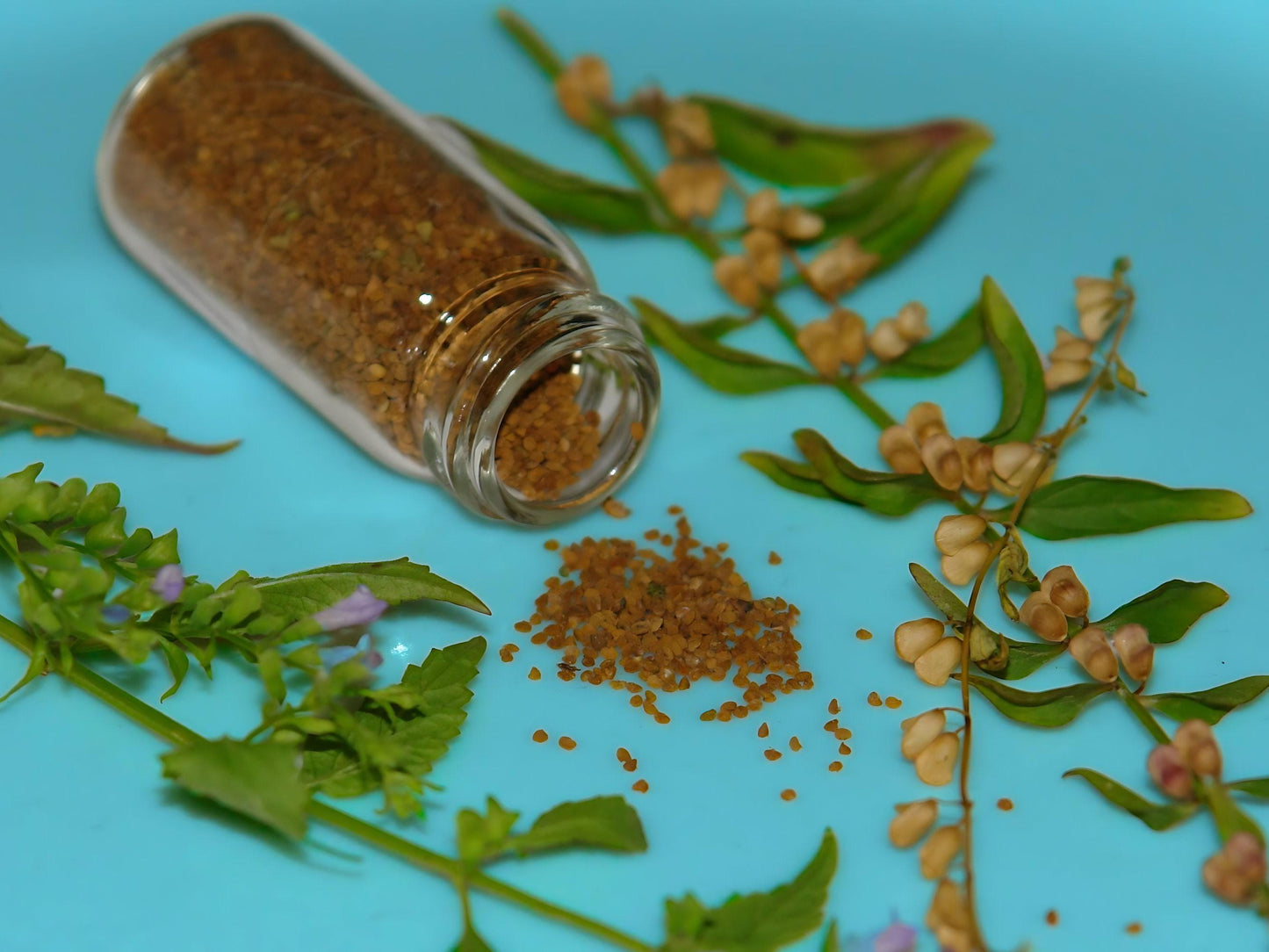(Scutellaria lateriflora) Native. Perennial. Mad Dog Skullcap, also known as Blue Skullcap or Side-Flowering Skullcap, is a cherished heirloom herb with a rich history in medicinal apothecaries. This perennial blooms with delicate blue flowers from mid-summer to early fall, attracting bees and butterflies to your garden. The plant thrives in wet-to-moist conditions, such as sedge meadows, swamps, bogs, and shorelines, and is slightly toxic to deer and rabbits, helping to protect it from these common pests.
Mad Dog Skullcap has long been valued in traditional herbal medicine for its calming properties. The leaves and flowers can be harvested when mature and dried for use in teas, tinctures, or extracts. Its slightly bitter taste means it is often mixed with other herbs to improve flavor. The name "skullcap" refers to the cap-like shape of its flowers and seed capsules, while "Mad Dog" reflects the outdated belief that it could cure rabies. Despite this myth, the plant remains popular for its historical and potential medicinal uses
• Scroll down for detailed growing info •
All Nimble NiteCap Seeds are:
• Heirloom
• Organic
• Non-GMO
• Open Pollinated
• Untreated
• US Grown
• growing instructions included
• Regular testing is conducted to uphold the highest germination standards, all the while employing appropriate seed storage techniques.
Sustainable Packaging & Shipping:
• NimbleNitecap seeds are packed in eco-friendly, compostable seed packets. Seed packets are printed in house with vegetable-based inks on biodegradable, recycled materials. (Small plastic bags are infrequently used to prevent the loss of very small seeds.)
• All orders are carefully packed and shipped with tracking via USPS First Class (or Priority, if selected) in padded ECOENCLOSE recycled and reusable mailers, or recycled boxes to protect your items in transit.
Most orders ship out the same or next business day! Please note that this time may be extended during peak season.
• FREE SHIPPING on all orders of $35 or more. Flat Rate shipping no matter how many packets you order.
• DIRECTIONS •
Common Names: Mad Dog Skullcap, Blue Skullcap, Virginia Skullcap
Latin Name: Scutellaria lateriflora
Type: Herbaceous Perennial
Life Cycle: Perennial
USDA Zones: 4-8
Stratification: 24 weeks in a damp paper towel, sealed in a plastic bag, and refrigerated
Germination Ease: Moderate
Sunlight: Full, Partial
Moisture: Wet, Medium-Wet
Soil: Prefers well-draining, rich in organic matter, pH between 5.5 and 7.0
Height: 2'
Plant Spacing: 12-18"
Spread: 12-18"
Color: Blue
Bloom Season: July, August, September
Advantages: Disease Resistant, Attracts Pollinators, Low Maintenance
Uses: Traditional medicine, ornamental purposes, attracts pollinators
Planting Depth: Surface sow, lightly press into the soil
Growth Habit: Upright
Companion Plants: Echinacea, Bee Balm, Black-Eyed Susan
Harvesting: Best harvested during bloom for medicinal use
Propagation: Seeds, division
Pests and Diseases: Generally pest resistant; monitor for aphids, caterpillars, and powdery mildew
Maintenance: Regular watering during dry periods, cutting back after flowering
Special Features: Tolerates wet soils, good for rain gardens
Toxicity: Nontoxic to humans and pets
~ sowing ~
Starting Seeds Indoors
Stratification: To improve germination rates, stratify the seeds by placing them in a damp paper towel, sealing them in a plastic bag, and refrigerating them for 2-4 weeks.
Timing: Start seeds indoors about 6-8 weeks before the last expected frost date in your area.
Containers: Use seed trays or small pots filled with a light, well-draining potting mix.
Sowing: Sprinkle the seeds on the surface of the soil and lightly press them in. Do not cover the seeds, as they need light to germinate.
Watering: Mist the soil gently to moisten it, ensuring it's consistently moist but not waterlogged.
Light and Temperature: Place the seed trays in a bright location with temperatures around 65-70°F (18-21°C). Use a grow light if necessary.
Germination: Seeds should germinate within 24 weeks. Keep the soil consistently moist during this period.
Transplanting Seedlings Outdoors
Timing: Once the seedlings have developed a few sets of true leaves and the risk of frost has passed, they can be transplanted outdoors.
Location: Choose a spot in your garden with well draining soil and partial to full sun.
Spacing: Space the plants about 12-18 inches apart to allow for proper growth.
Transplanting: Dig holes large enough to accommodate the root balls of your seedlings. Gently remove the seedlings from their containers, taking care not to damage the roots, and transplant them into the garden. Water well after planting.
~ growing ~
Watering: Keep the soil consistently moist, especially during dry periods. Water the plants deeply once or twice a week, depending on the weather and soil conditions.
Fertilizing: Mad Dog Skullcap doesn’t require heavy feeding. A light application of compost or a balanced organic fertilizer in the spring should be sufficient to support its growth.
Mulching: Apply a layer of mulch around the plants to help retain moisture and suppress weeds.
Pest and Disease Management: Mad Dog Skullcap is generally pest-resistant, but it’s still important to monitor for common garden pests like aphids and caterpillars. If you notice any pests, treat them with insecticidal soap or neem oil. Ensure good air circulation around the plants to prevent fungal diseases.
Maintenance: Mad Dog Skullcap can be cut back after flowering to encourage new growth and maintain a tidy appearance.
~ harvesting ~
When to Harvest: The best time to harvest is when the plant is in full bloom, usually from late spring to early summer.
How to Harvest: Use sharp scissors or pruning shears to cut the stems just above a set of leaves. This will encourage the plant to produce more growth. Avoid cutting more than onethird of the plant at a time to ensure it remains healthy.
Drying and Storing: Spread the harvested stems on a clean, dry surface in a wellventilated area, away from direct sunlight. Allow them to dry completely, which can take several days to a week. Once dried, strip the leaves and flowers from the stems and store them in an airtight container in a cool, dark place.



















